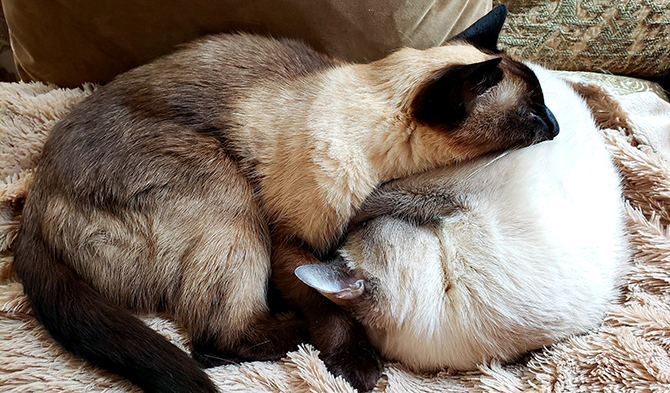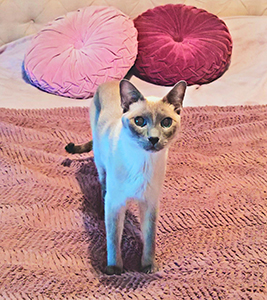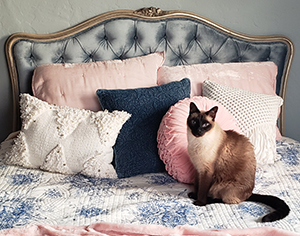6 Tips on How to Prevent (and Gracefully Conceal) the Cat Hair in Your Life

By Arielle Bennett and Dr. Eric Dougherty, DVM
Marie Kondo might be 2019’s genius in the art of tidying, but when it comes to being a cat parent, the question of discovering what creates joy in one’s home might be different when considering your cat’s needs as well. After all, our feline friends have fur for clothing and accessories that need to be in paw’s reach. Not all cats shed equally; many of my clients with several cats have no issues at all, but a few struggle to keep up with the cat hair in their lives. Between running a feline veterinary practice in Manhattan (www.thecatpractice.com) and having 4 cats at home, cats are always my focus in each space I inhabit. Beyond having a lint roller accessible for the hint of cat fluff on my all-black fashion choices, there are a few ways that might improve shedding if it has become a problem in your home.
Groom your cat regularly. Be it daily or weekly, it’s a good idea to brush your cat – not only will it help you bond with each other, but you will save them quite a few hairballs over the years. Each cat is unique, so if your cat is starting to leave hair everywhere, it needs some extra help grooming (this can also happen as cats age and tend to get more lazy, or in the summers when shedding is more pronounced). Remember, not all cats enjoy a rough brush. Some like soft silicone bristles and a gentle brushing motion, while others may prefer stiff bristles with more force than you’d ever let your hair stylist use! When you first begin, approach grooming sessions with tenderness; usually they will become quite infatuated with brushing given some time. Of course, long haired cats are another factor and should be brushed more often to prevent matting. Don’t wait too long to begin their grooming rituals; if a cat does become matted it can be painful for them. Pet groomers can also do beautiful work with “lion cuts” or a trim down. Their coats can grow slowly, so be careful about shaving them near fall and winter months if you live in a cold climate.

Find throws that match your furniture and hide your cat’s hair color. If your cat is a shedder, consider their coat’s color when buying furniture unless you don’t mind the upkeep. A plush throw can also be used to neatly cover an armchair seat cushion in a way that will make it look like part of the furniture. Besides, cats love the feel of blankets in faux fur, fleece, and sherpa style fabrics – and we have to consider their joy when decorating as well! If you like wood furniture, note that dark colors show more dust, so maybe spring for painted woods in light colors. Throws that cover chair cushions can also be easily tossed in a closet when guests are arriving, leaving a hair-free seat that won’t embarrass! If you’re in doubt about what colors are a good match, go with colors and patterns in neutral, earthy tones. Overall, I have found that faux fur in any color hides cat hair very well.
Utilize the color of your floors and rugs. When replacing flooring or buying rugs, keep in mind the flooring color will significantly hide or accentuate all manner of dirt and hair. Have you ever noticed how dirty white tiled floors look compared to a neutral stone like travertine? When I had a nice honey colored wood floor, it conveniently masked everything and needed little upkeep. Now that I have a dark wood floor I am unhappily sweeping, vacuuming, and mopping more than I ever have in the past. If you want a dark rug the same rule goes. Generally, a patterned rug will mask better than a solid color; and a looser knit, longer, or faux fur rug will hide debris better than a tighter knit, solid rug with nowhere for particles to hide.
Utilize the character of your living space. When I lived in Brooklyn I had a wonderful apartment shaped in a railroad design. One odd advantage was in its cleanliness factor because it was sloped a bit and the cat hair and dust fell nicely along one side. This imperfection made cleaning so easy and has since left me missing those days in that lovely, slanted living space. Lighting strategy can also be used to show or conceal a shedding situation. Use candlelight and lamps instead of overhead lighting if you’re trying to draw attention away from imperfections in a hurry. Sunlight has been (unfortunately) very motivating for me to clean the dark floors I live with now – but at night I use dim lighting and never notice the issue.

Invest in a robot vacuum. If you have an architecturally sound space that doesn’t slope like an old Brownstone in NYC, then investing in a robot vacuum might save you a great deal of cleaning effort. Some models can be put on a schedule and map out your rooms efficiently, and even self-empty their cannisters. Cheaper models are worth a go as well, they just might take a bit longer to get every corner. With automated vacuuming, it will also encourage you to organize cat accessories and clutter on the floors more regularly, since these vacuums won’t work well if they get caught on Tiger’s favorite toy rat.
When in doubt, take your cat to the vet. If you start to notice your cat is obsessively grooming herself, or showing signs of excessive hair loss, bald patches, or other sores on her skin, it’s time to go to the vet. Over-grooming and issues with hair loss in cats can sometimes be symptoms of things like stress, pain, allergies, nutritional issues, or other skin conditions that may require the help of your veterinarian.
Arielle Bennett and Dr. Eric Dougherty, DVM are The Cat Practice, veterinarians just for cats. For more information, go to www.thecatpractice.com.













